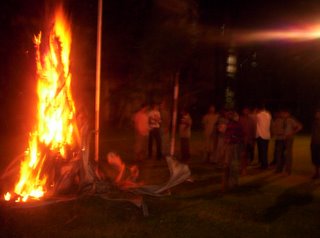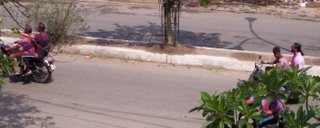Springtime Riot aka Holi
 Image courtesy: www.dialindia.com
Image courtesy: www.dialindia.comIf you are born in India and grow up here, you inevitably have a tough yet fun time keeping pace with festivals. There’s a saying in Bengali, “Baro mashe taro parban,” which literally translates to “Thirteen festivals in twelve months.” It’s a figurative way to say there are more festivals in this land than there are months in the calendar or seasons in the air.
And one of the wildest and most loved Indian festivals is Holi, which ushers in the spring season. If you didn’t know already, the highlight of this festival is colours. Colours that follow no disciplinary limits, no aesthetic codes, no regional, caste, class or religious barriers. Colours that you get smeared with wildly, whether or not you enjoy being splashed so. For on this one day, everything is allowed. And just in case you twitched your eyebrows to express resentment at such ribald behaviour, you will get a fresh dose of smearing with the slogan “bura na mano, holi hai!” (Don’t mind, it’s holi.) Traditionally, the festival is celebrated on the day after the full moon in March every year.
The Folklore:
Like most Indian festivals, Holi has its own set of legends, and traditions born out of these are followed to this day. Of the many holi stories, two are most popular.
The first one surrounds the myth of the demon king Hiranyakashyap and his son Prahlad. According to the legend, the demon king had commanded all his subjects to worship him and no one else. However, his own son, Parhlad defied him and turned an ardent devotee of Lord Vishnu (the sustainer in the Hindu trinity).
Unable to make his son follow his diktat, Hiranyakashyap made repeated attempts to kill Prahlad. When none of them worked, he turned to his sister Holika. She had been blessed with a boon that made her body immune to fire. So the ploy hatched by the demon king and his sister saw Holika entering a burning pyre with Prahlad on her lap.
However, what Holika overlooked in her attempt to kill her nephew was that the boon worked only when she entered fire alone, not with someone. Prahlad on the other hand, kept chanting Vishnu’s name as the flames raged on. In the end, Holika was burnt to ashes while Prahlad came out unscathed.
To this day, effigies of Holika are burned to symbolize the victory of good over evil. Huge bonfires are lit and in some regions of India, people even offer harvest produce to the fire.

The second folklore revolves around the eternal romance of Lord Krishna and his beloved Radha. As a child, Krishna was known for his mischief. One day, he went to his mother Yashoda and complained how nature had been unfair in making him dark and Radha so fair. To humour the young Krishna, Yashoda told him to go and smear Radha’s face with colour. And so, armed with the license of motherly lenience, Krishna promptly went and applied colour on Radha’s face so as to make her like himself. Krishna’s prank of splashing Radha and her girlfriends with pichkaris (water jets) caught on the fancy of local people and is now a full-fledged Holi tradition. Children are particularly fond of the pichkaris and they come in every shape and colour.
 Image courtesy: www.masters-gallery.com
Image courtesy: www.masters-gallery.com The Frolick:
My earliest memories of Holi are filling up balloons with coloured water and hurling them at my friends. Being a dimwit, I was the one who came drenched after the play. As for my water balloons, well, my missiles almost always missed the mark and left potential victims unblemished. Sigh. This unfair victimization could be one reason, I started disliking Holi as I grew up. One particular year took my distaste to a new height. That year we went to one of our relatives houses to play Holi. Along with colours, dry and wet, they smeared a weird concoction all over my head—colours mixed with anti-lice oil! As someone who has long hair that takes ages to be rid of colour, I can tell you, that wasn’t nice. Not nice at all.
As un-holi as I have grown up to be (I usually keep in hiding inside my room, to the best of my ability), it amuses me no end to see my brother on Holi every year. He loves playing it with his equally wild friends. He would typically leave the house in the morning donning a spotless white t-shirt. By evening, when he makes a return, you won’t recognize him, for he turns into a ghostly spectacle. The spotless white gets transformed into a multicoloured, disfigured, beyond-abstract piece of art.

The Food:
Holi is big in North India. It’s one of the two biggest festivals in fact (the other one is Diwali). Suffices to say, food forms an important part of the festivities. Traditionally, bhang an intoxicating herb, extracted from the leaves and buds of cannabis, takes the lead in edible preparations. It is consumed in different ways, all equally potent—in a milky-nutty drink called thandai, fried into fritters, and made into chewy little balls called golees.
Other traditional Holi foods include puran poli (sweet stuffed pancake), kanji ke vade (lentil patties), gujia (sweet stuffed pastries), and malpua (fried pancakes dipped into sugar syrup).
I cooked a rare non-veg dish that manages to sneak into the above list. It was easy to make and tasted rather nice too.
Meat Kofta Curry:
Ingredients:
For kofta or meatballs:
Minced Mutton: 400 gms
Ginger-garlic paste: 1 tsp
Coriander leaves: 1 tsp (finely chopped)
Mint leaves: ½ tsp (finely chopped)
Garam Masala: ½ tsp
Black pepper powder: ½ tsp
Salt
For Curry:
Onions: 2, chopped
Bay leaves: 2
Ginger-garlic paste: 1 tsp
Tomato puree: 1 tbsp
Turmeric: A pinch
Garam masala: ½ tsp
Salt
Method:
1. Mix the minced meat with the other ingredients for the kofta and keep aside.
2. Heat oil in a wok and fry the onions till light brown.
3. Add the bay leaves, ginger-garlic paste, tomato puree, turmeric and salt. Fry well.
4. Add two glasses of water (or less if you want a thicker gravy) to the wok and bring it to a boil.
5. Make balls out of the minced meat mixture and start dropping them into the gravy.
6. Turn the flame low, cover and allow cooking until the koftas are done.
7. Add a pinch of garam masala just before removing from heat.
8. Serve with hot plain rice or chapatti/parantha.

This was reasonably easy to make and tasted rather nice. I will be making it more often. I hope you do too :)
Sury


6 comment(s):
HAppy Holi, sury! :)
By Anonymous, at
11:10 PM
Anonymous, at
11:10 PM
What a lovely write up. I join you in being slightly afraid of the colorful festival:-)...And how can one forget how Holi has been glamourised in countless Bollywood movies, the most famous being Silsila and Sholay!!! Your koftas looks delish
By Anonymous, at
3:33 AM
Anonymous, at
3:33 AM
Happy belated Holi...Sury,loved reading your informative post.
The kofta recipe,sounds delicious.could I try this with chicken too..?
By Anonymous, at
8:57 AM
Anonymous, at
8:57 AM
Thanks, Kay!
Ashwini, I am glad you liked the post. And yes, there should have been one more segment there -- "The Films." Don't know how that slipped my attention. :P
Happy belated Holi to you too, Lera! Of course you can make the koftas with chicken. Here we are just staying away from chicken because of the bird flu scare.
By Anonymous, at
9:23 AM
Anonymous, at
9:23 AM
Hi Thanks for dropping by my blog & adding me to your links. Will add you too.
And Happy Holi...belated :).
By Anonymous, at
3:16 AM
Anonymous, at
3:16 AM
Thank you too, Sonali for dropping by and commenting :)
By Anonymous, at
8:48 AM
Anonymous, at
8:48 AM
Post a comment
<< Home